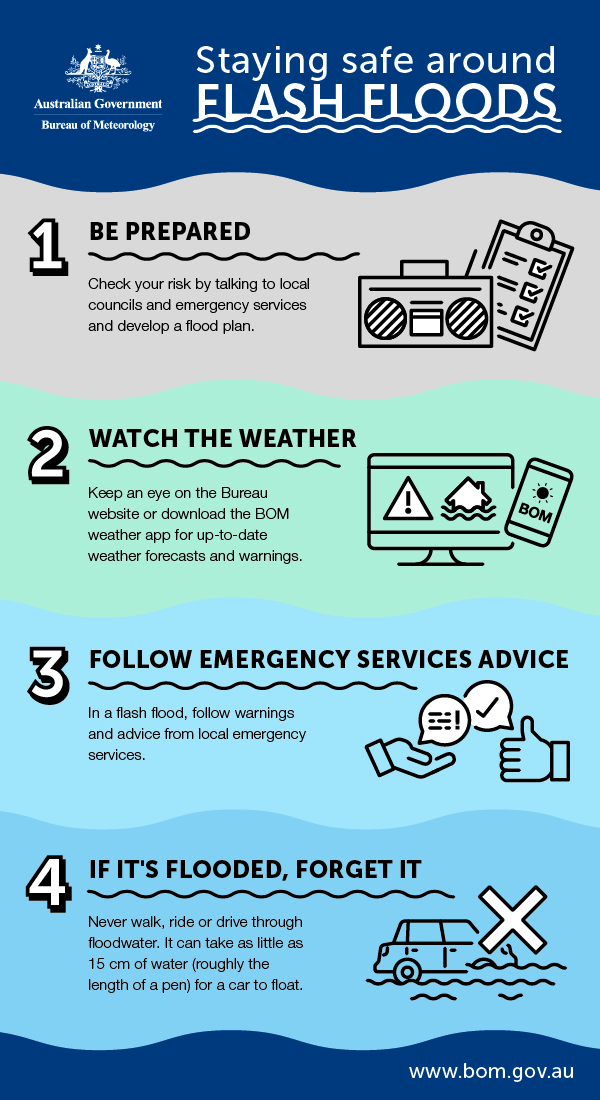How To Prepare For Flash Floods: Understanding Alerts And Taking Action

Table of Contents
Understanding Flash Flood Alerts and Warnings
Knowing when and how to respond to flash flood alerts is paramount. This section outlines how to recognize the signs of impending danger and where to find reliable information.
Recognizing the Signs of an Impending Flash Flood:
Flash floods don't always announce themselves with dramatic fanfare. Being aware of subtle changes in your environment can be the difference between safety and danger. Look out for:
- Rapidly rising water levels: A significant and sudden increase in the water level of streams, creeks, rivers, or even normally dry washes is a major warning sign.
- Intense and prolonged rainfall: Heavy downpours, especially over saturated ground, can quickly lead to flash flooding. Pay close attention to weather forecasts, especially during periods of intense storms.
- Sudden increase in water flow: Observe changes in the speed and volume of water in local waterways. A dramatic increase in flow rate is a key indicator.
- Changes in water color or unusual debris: Murky water or the presence of unusual debris (logs, branches, etc.) can signal increased upstream water flow and potential flooding downstream.
- Localized flooding in low-lying areas: Observe if low-lying areas near your home or community begin to flood. This often precedes wider flooding.
Official Sources for Flash Flood Alerts:
Reliable information is your best defense. Stay informed through these channels:
- National Weather Service (NWS): The NWS provides critical flash flood warnings and watches via its website (weather.gov) and mobile app. Sign up for alerts in your specific area.
- Local news channels and weather reports: Local news broadcasts often provide timely updates and localized flash flood information.
- Emergency alert systems: Your mobile phone likely receives Wireless Emergency Alerts (WEA) – ensure this feature is activated on your device. These alerts can deliver crucial information during a flash flood event.
- Community warning systems: Many communities utilize sirens or other warning systems. Familiarize yourself with the location of sirens and the sound they emit.
Differentiating Between Watches, Warnings, and Advisories:
Understanding the meaning of different alerts is critical for effective response:
- Watch: A flash flood watch means conditions are favorable for flash flooding to develop. This is a time to prepare, monitor conditions closely, and have your emergency plan in place.
- Warning: A flash flood warning means flash flooding is imminent or is already occurring. This is a critical time to take immediate action, evacuate if necessary, and move to higher ground.
- Advisory: A flash flood advisory indicates that flooding is possible. While the risk is lower than with a warning, it is still important to exercise caution and monitor conditions.
Creating a Flash Flood Emergency Plan
A well-defined emergency plan can save lives and reduce the impact of a flash flood.
Identifying High-Risk Areas:
Proactive identification of risk is crucial:
- Map out flood-prone areas: Identify areas in your home and community that are historically prone to flash flooding.
- Plan evacuation routes: Know multiple routes to higher ground and identify potential safe locations outside the flood zone.
- Safe shelter locations: Locate sturdy buildings or designated shelters in your area suitable for refuge during a flash flood.
Building an Emergency Kit:
Preparation is key. Assemble a kit that includes:
- Water: One gallon per person per day for at least three days.
- Non-perishable food: Easy-to-prepare, non-perishable food items.
- Flashlight and extra batteries: Essential for navigating darkness during and after a flood.
- First-aid kit and medications: Include essential medications and first-aid supplies.
- Copies of important documents: Keep copies of identification, insurance policies, and other crucial documents in a waterproof container.
- Whistle: A whistle can be used to signal for help if you become trapped.
- Emergency radio: A hand-crank or battery-powered radio will provide crucial updates during a power outage.
Developing a Communication Plan:
Effective communication is vital:
- Meeting place: Designate a safe meeting place for your family to gather after a flash flood.
- Out-of-state contact: Choose an out-of-state contact person to act as a central point of contact for family members.
- Charged devices: Ensure cell phones and other communication devices are fully charged.
Actions to Take During a Flash Flood
Responding swiftly and decisively is crucial when a flash flood warning is issued.
Immediate Actions Upon Receiving a Warning:
Time is of the essence:
- Move to higher ground immediately: Do not delay. This is the single most important action you can take.
- Do not drive through flooded areas: Even shallow water can sweep vehicles away. Turn around, don't drown.
- Never walk or swim through floodwaters: Floodwaters are often contaminated and contain hidden dangers.
- Turn off utilities: Turn off gas, electricity, and water if instructed to do so by authorities.
If Trapped by Flash Flood Waters:
If trapped, prioritize safety:
- Move to the highest level: If in a building, move to the highest level possible.
- Abandon a flooded vehicle: If your vehicle becomes flooded, get out immediately and move to higher ground.
- Call emergency services: Call 911 or your local emergency number for help.
Post-Flash Flood Actions and Recovery
After the immediate danger has passed, recovery begins.
Assessing Damage and Safety:
Proceed with caution:
- Wait for official clearance: Wait for authorities to declare the area safe before returning to your home.
- Check for structural damage: Carefully assess your home for structural damage and potential hazards.
- Avoid contact with floodwaters: Floodwaters can be contaminated with sewage and hazardous materials.
- Report damage: Report any damage to your home or property to local authorities and your insurance company.
Cleaning and Repairing Your Home:
Cleaning up after a flood requires caution and safety:
- Use appropriate safety gear: Wear protective gear, including gloves, boots, and masks, while cleaning up.
- Discard contaminated items: Discard any items that have been in contact with floodwaters.
- Contact your insurance company: File a claim with your insurance company as soon as possible.
Conclusion
Preparing for flash floods is essential for safeguarding your life and property. By understanding flash flood alerts, developing a comprehensive emergency plan, and knowing how to react during and after a flood, you significantly reduce your risk. Remember to stay informed, stay vigilant, and always prioritize safety when dealing with flash flood threats. Take action today to prepare for flash floods and protect your family. Learn more about flash flood safety and resources in your area. Don't wait for a flash flood to hit – prepare for flash floods now and protect your loved ones.

Featured Posts
-
 The Truth About Lauryn Goodmans Move To Italy Following Kyle Walkers Transfer
May 25, 2025
The Truth About Lauryn Goodmans Move To Italy Following Kyle Walkers Transfer
May 25, 2025 -
 Latest Court Ruling Against Trump In Elite Law Firm Dispute
May 25, 2025
Latest Court Ruling Against Trump In Elite Law Firm Dispute
May 25, 2025 -
 Mercedes F1 Toto Wolffs Hints On George Russells Future
May 25, 2025
Mercedes F1 Toto Wolffs Hints On George Russells Future
May 25, 2025 -
 George Russells Mercedes Future What Did Toto Wolff Say
May 25, 2025
George Russells Mercedes Future What Did Toto Wolff Say
May 25, 2025 -
 France Revisits Dreyfus Affair Lawmakers Seek Posthumous Military Promotion
May 25, 2025
France Revisits Dreyfus Affair Lawmakers Seek Posthumous Military Promotion
May 25, 2025
Latest Posts
-
 Rising Tennis Culture In China Impact Of Top International Players
May 25, 2025
Rising Tennis Culture In China Impact Of Top International Players
May 25, 2025 -
 I Mercedes Kai I Pithanotita Apoktisis Toy Verstappen
May 25, 2025
I Mercedes Kai I Pithanotita Apoktisis Toy Verstappen
May 25, 2025 -
 Chinas Tennis Culture Boosted By Top Players Italian Open Director
May 25, 2025
Chinas Tennis Culture Boosted By Top Players Italian Open Director
May 25, 2025 -
 Analyzing George Russells Game Changing Decision For Mercedes
May 25, 2025
Analyzing George Russells Game Changing Decision For Mercedes
May 25, 2025 -
 I Mercedes Apomakrynetai Apo Ton Verstappen
May 25, 2025
I Mercedes Apomakrynetai Apo Ton Verstappen
May 25, 2025
